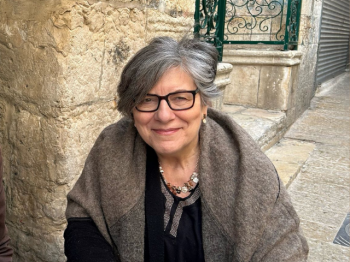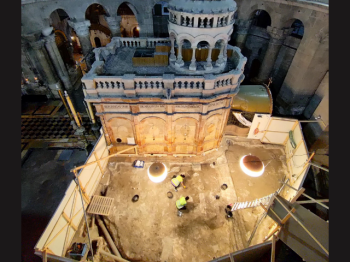“I lived inside the Basilica of the Holy Sepulchre for three years”

Francesca Romana Stasolla is a full professor of Christian and Medieval Archaeology at the “La Sapienza” University of Rome and a member of the Pontifical Roman Academy of Archaeology. She leads several archaeological excavation projects, including the one carried out during the interventions on the floor of the Basilica of the Holy Sepulchre.
Professor, during the archaeological excavations that preceded the interventions on the flooring of the building, you spent many months inside the Holy Sepulchre in Jerusalem. How did you feel during this privileged experience?
Together with the team of archaeologists, and colleagues from other disciplines (botanists, geologists, archaeozoologists, historians, philologists, etc.) from the “La Sapienza” University, we spent about three years inside the basilica, with a brief interruption only after the events of October 7, 2023. It is an extraordinary opportunity both from a professional and human point of view. We never imagined we would be able to conduct excavations in such a sacred place, where the entire history of Jerusalem is encapsulated, from the Iron Age – i.e. from the 8th century BC onwards – up to the present day.
From a human point of view, what impressed us was the ability of the various communities to live together in Jerusalem, a city that is the epitome of multiculturalism and multi-religiosity. We were profoundly changed during the months spent observing this “permanent miracle” of coexistence amidst the local social and religious complexities.
It was an exercise of trying to assimilate ourselves discreetly into this harmonious complexity, which greatly opened our minds. We tried to understand without judging, and sometimes we also accepted that we could not understand certain situations, while still remaining humanly close to the people we met. It was about building bridges between all the worlds that intersect at the Holy Sepulchre. We got to know everyone, and gradually found the keys to relationships, which allowed us to integrate more and more into the reality of the Resurrection sanctuary. Now, we have many friends in Jerusalem. How would you define the Holy Sepulchre? It is not simply a “church,” for it is a “sanctuary,” open freely to everyone, without any entrance checks, located in the heart of the Old City of Jerusalem. As I mentioned, I lived within the Holy Sepulchre for three years, and this extraordinary place inspires peace. You cannot break down an open door! This permanent spiritual hospitality embodied by the basilica disarms hearts and encourages contemplation, mutual respect, understanding beyond differences, and openness to others. This coexistence is remarkable, especially in such a historically difficult moment, which is so full of conflicts.




